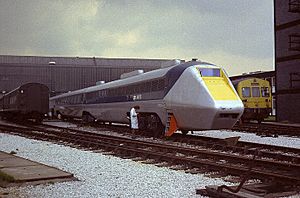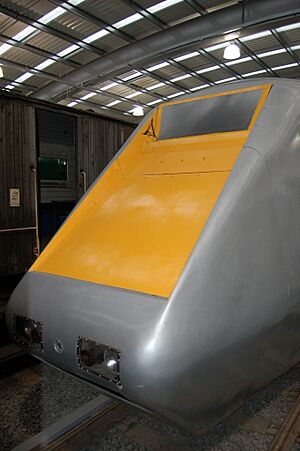British Rail APT-E facts for kids
Quick facts for kids British Rail Advanced Passenger Train-Experimental |
|
|---|---|

APT-E in the RTC sidings between tests in the summer of 1972
|
|
| In service | 1972-1976 |
| Manufacturer | BR Research & Technical Centre |
| Built at | Derby |
| Family name | APT |
| Constructed | 1970 |
| Entered service | 1972-1976 |
| Formation | 4 cars |
| Fleet numbers | PC1-2 (Power Cars) TC1-2 (Trailer Cars) |
| Operator(s) | British Rail |
| Specifications | |
| Maximum speed | 155mph |
| Prime mover(s) | Gas Turbine |
| Braking system(s) | Hydrokinetic |
| Track gauge | Standard |
The APT-E (which stands for Advanced Passenger Train Experimental) was a special tilting train built to test new ideas. It was the very first version of the Advanced Passenger Train series. This train was unique because it was powered by gas turbines. This made it the only train of its kind used by British Rail.
The APT-E was made up of four parts, called "cars." Two were power cars (named PC1 and PC2) that made the train go. The other two were trailer cars (TC1 and TC2) that rode in between. To make the train lighter, its cars were built from a material called aluminium. They were also "articulated," meaning they were connected in a flexible way. This design helped reduce the train's weight and allowed it to move more smoothly.
Contents
What was the APT-E for?
The main goal of the APT-E was to test new railway technologies. Engineers wanted to see if a train could go very fast on existing tracks. They also wanted to make train journeys more comfortable for passengers. The "E" in its name stands for "Experimental" because it was a test train.
Tilting Technology
One of the most exciting features of the APT-E was its "tilting" system. When a train goes around a curve, passengers can feel pushed to the side. The APT-E was designed to lean into curves, just like a cyclist on a bike. This tilting action helped the train go faster around bends. It also made the ride much smoother and more comfortable for anyone on board.
Gas Turbine Power
The APT-E used gas turbines for power. These are like jet engines, but they drive the train's wheels instead of pushing it through the air. This was a very new idea for trains in Britain. Gas turbines are powerful and can make a train go very fast. The APT-E could reach speeds of up to 155 miles per hour (249 km/h).
When was the APT-E used?
The APT-E was built in 1970 and started its tests in 1972. It was used for experiments until 1976. During these years, it helped engineers learn a lot about high-speed rail. The information gathered from the APT-E was used to design future high-speed trains. Even though the APT-E itself was never used for regular passenger service, its tests were very important.
Where is the APT-E now?
After its testing days were over, the APT-E was preserved. Today, you can see parts of this historic train at the National Railway Museum Shildon, also known as Locomotion. It stands as a reminder of the exciting efforts to make trains faster and better.
Related pages
Images for kids
-
APT-E at Locomotion, Shildon, County Durham



